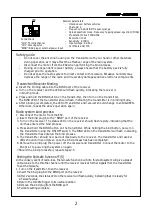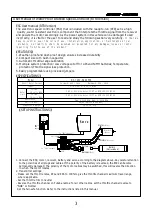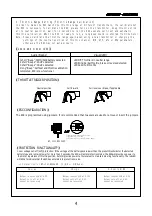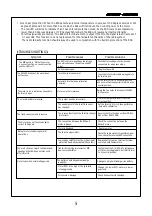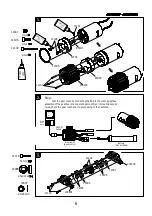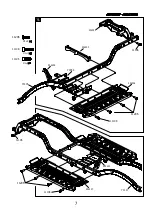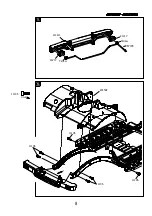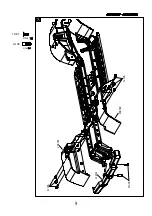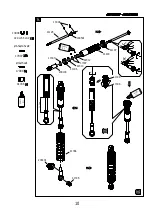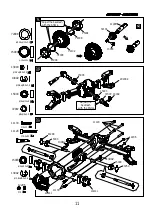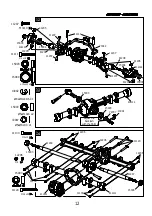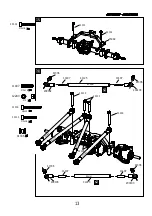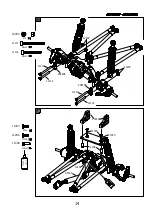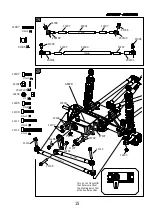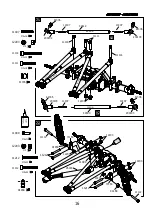
Radio system instructions
Caution
1
To prevent serious personal injury and/or property damage,operate all remotely
controlled models in a responsible manner as outlined herein.
Safety Precautions
1.1 This radio-controlled model is not a toy, it is designed for persons 14 years of age or older.
1.2 Do not operate your vehicle on unsafe terrain; always pay attention to your surroundings.
1.3 Never operate your vehicle on public roadways, around moving people, animals, or operating machinery.
1.4 Keep clear of power lines and high-powered radio equipment to minimize radio frequency interference.
1.5 Since this vehicle contains small components, it may be a choking hazard for small children. Keep the vehicle and
any spare parts out of reach of small children.
Inspect your radio-controlled model before operation
2.1 Ensure that all screws are properly tightened. Use thread-lock to secure any metal to metal contacts- especially for components designed
to withstand torque (servo mounts, motor mount, drive shaft grub screws etc.).
2.2 Always check the battery voltage for both the transmitter and vehicle prior to operating your vehicle. Keep the batteries fresh in the
transmitter and always begin your vehicle runs with a fully charged battery pack.
2.3 Always check that the motor and servo are operating smoothly and in the right direction prior to operation. If binding between
components is observed, replace parts as necessary to reduce possibility of component or servo damage.
2.4 To turn on your vehicle, always power on your transmitter first, then power on your receiver.
After operating your radio-controlled model
3.1 To turn off the vehicle, always power off your receiver prior to powering off your transmitter.
3.2 Use caution when handling the vehicle- components, especially the ESC and motor which will be hot after operation.
3.3 Never use battery packs which are dented or otherwise damaged. Ensure that the wire insulation is intact and that connectors are
properly soldered. Lithium batteries can become fire hazards if mishandled.
A
B
C
D
E
F
G
H
I
J
K
L
M
A. On/Off switch: Ensure that the throttle and steering channels
are at their neutral position prior to turning on the transmitter.
B. Steering rates: Increases or decreases the maximum steering
servo deflection.
C. Throttle trim: Adjusts the neutral position of the throttle output.
D: Steering trim: Adjusts the neutral position of the steering servo.
E: Bind button: Used for binding the transmitter to the receiver.
F: Antenna: An internal 2.4GHz antenna is located at this position.
G: Steering wheel: Proportional control for the steering servo.
H: Throttle trigger: Proportional control for the ESC and motor output.
I: Battery compartment: Accepts 4x
“
AA
”
batteries.
J: Power LED: Flashes when battery voltage is low.
K: Steering reverse: Reverses the direction of travel for the
steering servo.
L: Throttle reverse: Reverses the direction of travel for the
motor output .
M: Bind LED Flashes during the binding process.
Caution
Do not obstruct the antenna cover as it may reduce the operating range of
the radio system.
Transmitter Specifications
-
Intended use: Surface vehicles
-
Number of channels: 2
-
Frequency: 2.4GHz ISM Frequency range
-
Spread spectrum mode: Frequency hopping spread- spectrum (FHSS)
-
Modulation format: FSK/GFSK
-
Output power: <100mW
-
Operating current < 150mA
-
Resolution: 1024uS
-
Proportional throttle and steering controls
-
Steering servo dual rates
-
Throttle EPA
-
Low voltage warning
-
Fail safe protection
-
Certificates: CE/FCC
Summary of Contents for CZRFR4RTR
Page 8: ...5 8 21217 21217 87078 Yellow Yellow 6 201504 11106 M3x8 11106 11106 11106 11106 200910 ...
Page 9: ...7 M3x8 11303 11106 M3x8 11106 11106 11303 204301 204302 9 205008 ...
Page 24: ...37 85112 204203 204204 M3x8 11303 11303 11207 M3x10 11207 24 UP 35 34 ...
Page 25: ...36 25 B A T T E R Y N o t i n c l u d e d ESC Receiver ...
Page 26: ...26 94015 94015 37 ...
Page 27: ...27 ...


